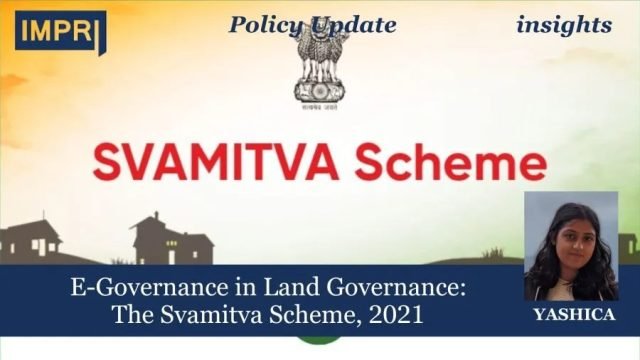Policy Update
Yashica
Introduction
“The Future of India lies in its villages” – Mahatma Gandhi
This famous quote by Mahatma Gandhi puts emphasis on the need to develop village economies for the country to truly develop. Information Technology is increasingly becoming the need of the hour, using this technology in order to resolve land disputes and foster inclusive growth is the main aim of the SVAMITVA Scheme.
The Scheme
Launched on 24th April 2021, the SVAMITVA Scheme (Survey of Villages Abadi and Mapping with Improvised Technology in Village Areas) is a Central Sector Scheme under the Ministry of Panchayati Raj. The scheme is a collaborative effort of the Ministry of Panchayati Raj, the State Revenue Department, the State Panchayati Raj Department and Survey of India. Winner of the best innovation award 2024 at the Indian School of Business., this scheme aims to establish clear ownership of property in rural areas by mapping of land parcels using drone technology, documenting a ‘Record of Rights’ and issuing legal ownership cards to property owners. The scheme also aids in reducing property-related disputes and facilitating bank loans.
The Geographic Information System (GIS) maps created under this scheme will not only aid in preparing better quality Gram Panchayat Development Plan (GPDP) but can also be accessed by other departments for its use, for example, the Ministry of Home Affairs.
The technology used for mapping under the scheme is CORS (Continuously Operating Reference Station). It’s a permanently located network of GNSS (Global Navigation Satellite System) receivers, such as GPS (Global Positioning System) that continuously collect data. By receiving signals from multiple satellites, CORS can calculate data effectively thus making it an essential technique for mapping. This modernising technique enables more efficient and accurate decision-making across various sectors and disciplines.
Implementation and Funding
The scheme was initiated through the pilot projects. After the success of these projects, the scheme was launched and its implementation consists of a flow of activities. The Pre-Survey activities include forming agreements between different states and the Survey of India, Panchayats conducting public awareness campaigns to inform rural populations, selecting of sites for CORS establishment, and notifying villagers regarding the survey. Additionally, training workshops and capacity-building sessions are provided by the Survey of India, and demarcating residential and parcel areas are further steps in the activity.
During the Survey phase, drone-based surveys are conducted to capture aerial imagery using Ground Control Points. The Survey of India then uses these images to generate property maps and high-resolution spatial data. Post-survey activities involve the verification of maps on the ground and data collection on property ownership by the State Revenue Department and Gram Panchayat. An inquiry and objection process is conducted with the gram sabha and landowners. Subsequently, property cards are printed and distributed to household owners in the village by the state.
“The scheme has been approved for a financial outlay of Rs. 566.23 crores for five years from 2020-25” as mentioned in the Report of Expert Committee on the SVAMITVA Scheme. The expenditure includes the establishment of a CORS network, drone network, documentation, workshops and so on.
The Impact
Under the scheme, over 2 lakh drone surveys and over 9 crore parcels have been digitised as of 2024. Over 1.66 crore property cards have been prepared for 1.06 lakh villages as of this year. Moreover, the scheme has achieved full coverage in several regions, including Haryana, Uttarakhand, Andaman and Nicobar Islands, and Goa, where property cards have been generated for all inhabited villages. This scheme aims at holistic development and inclusive growth across rural India.
By giving property rights to villagers, the scheme not only enhances the socio-economic standards of vulnerable village populations but also addresses the long-standing issue of land conflicts by demarcating land boundaries. Additionally, the SVAMITVA scheme promotes sustainable habitats by using the CORS technique and digital mapping for surveys. These maps are also used for optimising infrastructure development and resource allocation under panchayat development plans. Moreover, the scheme fuels economic growth by structuring property tax systems and attracting investments. It aims to foster inclusive growth with the help of sustainable practices.
Recommendations
The expert committee on the scheme suggested certain recommendations. As per the experts, officials of Survey of India face challenges in terms of delay in notifying villagers, delayed availability of ownership data and so on. These in turn lead to delays in completing survey work. To address this situation, village-level monitoring and establishment of the National Programme Management Unit and State Programme Management Units is essential to effectively oversee and manage the scheme.
Additionally, the use of IT platforms in managing data and producing reports is essential for effective management. Since various government departments and private agencies will utilise this data, safeguarding it against manipulations is paramount. To achieve this, the data should be categorised based on its level of sensitivity, and security features.
The Ministry of Panchayati Raj, in collaboration with stakeholders, should develop protocols and guidelines to uphold the security of this data. In light of ‘Viksit Bharat,’ the scheme has immense potential provided the loopholes are addressed.
References
- (n.d.). SVAMITVA Portal. Retrieved April, 2024, from https://svamitva.nic.in/svamitva/about.html?OWASP_CSRFTOKEN=Q95C-A34P-5REO-N9PN-F8LW-HYAW-8WZX-YJE3
- (n.d.). Press Information Bureau. Retrieved April 29, 2024, from https://pib.gov.in/PressReleasePage.aspx?PRID=2003524
- (n.d.). The Expert Committee Report. Retrieved April 29, 2024, from https://svamitva.nic.in/DownloadPDF/ExpertCommitteeReportFinalReport_1678960275389.pdf
- (n.d.). Panchayat.gov.in. Retrieved April 29, 2024, from https://panchayat.gov.in/document/svamitva-guidelines/
- (n.d.). Hindustan Times. Retrieved April 29, 2024, from https://www.hindustantimes.com/india-news/all-you-need-to-know-about-svamitva-scheme-and-its-coverage/story-qwMGmugQXo0cnhFQq9tCYM.html
- Press Information Bureau. (2024, January 6). Press Information Bureau. Retrieved April 29, 2024, from https://pib.gov.in/PressReleasePage.aspx?PRID=1993736
Acknowledgement: Yashica is a Research Intern at IMPRI and currently pursuing B.A. Political Science Honours from Sri Venkateswara College, University of Delhi.
Read more at IMPRI:



















